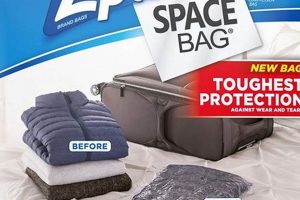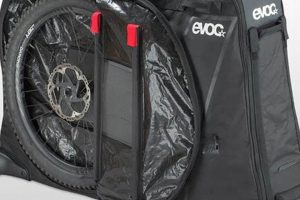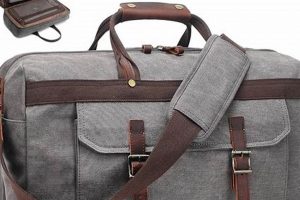These receptacles, designed for the temporary containment of soiled clothing during transit, are essential accessories for individuals undertaking journeys of any duration. They provide a dedicated space for separating used garments from clean ones, aiding in organization and preventing the commingling of odors. A common example includes a foldable, nylon bag used to keep dirty clothes separate during a week-long vacation.
The employment of such organizational tools offers several advantages. It promotes hygiene by isolating potentially contaminated items. Furthermore, it contributes to efficient packing and unpacking, saving time and minimizing the risk of losing or misplacing articles of clothing. Historically, simpler versions like cloth sacks have served similar purposes, but modern iterations offer enhanced durability, water resistance, and space-saving designs. This evolution reflects a growing awareness of the need for practical and hygienic travel solutions.
Given their role in maintaining order and cleanliness, various aspects of these items merit further examination. Consideration should be given to material selection, size and portability, closure mechanisms, and specialized features such as odor control or compression capabilities. Subsequent sections will delve into these characteristics, providing a comprehensive overview to aid in informed selection.
Optimizing the Use of Laundry Bags During Travel
The following recommendations are designed to enhance the efficiency and effectiveness of utilizing receptacles for containing soiled clothing while traveling. Adherence to these guidelines can contribute to improved hygiene, organization, and overall travel convenience.
Tip 1: Prioritize Material Durability. Select bags constructed from robust, tear-resistant materials such as nylon or polyester. This ensures the bag can withstand the rigors of travel and prevent accidental damage or spillage. For example, reinforced seams and a water-resistant coating further enhance durability.
Tip 2: Optimize Size and Portability. Choose a bag that adequately accommodates the anticipated volume of soiled clothing without being excessively bulky or cumbersome. A foldable or compressible design allows for efficient storage when not in use. Consider the dimensions when packed to ensure compatibility with luggage constraints.
Tip 3: Implement Effective Closure Mechanisms. Opt for bags featuring secure closure systems such as zippers, drawstrings, or buckles. These mechanisms prevent the accidental escape of contents and minimize the spread of odors. A well-sealed bag also provides a barrier against potential contaminants.
Tip 4: Segregate Clothing by Type. Utilize multiple, smaller bags to separate different types of soiled clothing, such as undergarments, activewear, or items requiring special care. This compartmentalization promotes hygiene and prevents the mixing of potentially problematic items. Labeling each bag can further enhance organization.
Tip 5: Address Odor Management Proactively. Select bags incorporating odor-absorbing materials, such as activated charcoal or antimicrobial linings. Alternatively, consider including dryer sheets or fabric freshener sachets within the bag to mitigate unpleasant smells. Regularly air out the bag between uses to prevent odor buildup.
Tip 6: Emphasize Proper Cleaning and Maintenance. Routinely clean and disinfect the receptacles to prevent the growth of bacteria and mold. Follow the manufacturer’s instructions for washing or wiping down the bag’s interior and exterior surfaces. Allow the bag to dry completely before storing to prevent moisture-related issues.
Tip 7: Consider Compression Features. Bags with compression capabilities, such as integrated straps or vacuum sealing options, can significantly reduce the volume of packed clothing. This is particularly beneficial for longer trips or when space is limited. However, exercise caution to avoid over-compressing delicate items.
The effective utilization of travel receptacles for soiled clothing necessitates careful consideration of material properties, size constraints, closure mechanisms, and odor management strategies. By adhering to these recommendations, travelers can maintain a higher standard of hygiene, organization, and convenience throughout their journeys.
The subsequent section will address specific product types and their suitability for various travel scenarios, providing further guidance for informed purchasing decisions.
1. Material Durability
Material durability constitutes a primary determinant of the lifespan and performance of receptacles designed to contain soiled clothing during travel. The capacity of the material to withstand the rigors of transit directly impacts the bag’s ability to effectively serve its intended purpose. Inadequate durability results in premature wear, potential tearing, and compromise of containment, leading to inconveniences and potential hygiene concerns.
- Tear Resistance
Tear resistance refers to the material’s ability to resist propagation of a tear once initiated. Materials with low tear resistance are susceptible to damage from sharp edges or snags within luggage compartments. For example, a bag constructed from thin, non-woven fabric is likely to tear under stress, whereas ripstop nylon, with its interwoven reinforcement threads, provides significantly greater tear resistance. In the context of laundry bags, tear resistance ensures that the bag remains intact, preventing the spillage of soiled clothing and potential contamination of other items within the luggage.
- Abrasion Resistance
Abrasion resistance is the material’s ability to withstand surface wear from rubbing or friction. During travel, receptacles for soiled clothing are subjected to constant friction against other items in the luggage. Materials with low abrasion resistance exhibit premature wear, thinning, and eventual failure. For instance, cotton canvas, while durable in some respects, is less abrasion-resistant than materials such as coated polyester or ballistic nylon. Adequate abrasion resistance ensures that the bag maintains its structural integrity and appearance over prolonged use.
- Water Resistance/Proofing
Water resistance and, ideally, water proofing, are critical for preventing moisture penetration from external sources or from damp clothing contained within the bag. Materials with inadequate water resistance allow moisture to seep through, potentially damaging other items in the luggage or promoting the growth of mold and mildew within the bag itself. Examples include polyurethane-coated fabrics and waterproof nylon, which provide a barrier against moisture. The presence of water-resistant or waterproof materials contributes to a more hygienic and odor-controlled environment within the travel bag.
- Seam Strength
While the material itself may possess high durability, the strength of the seams connecting the various panels is equally crucial. Weak seams represent a point of failure, even if the surrounding material remains intact. Reinforced seams, utilizing techniques such as double stitching or binding, enhance the overall durability of the bag. For example, a bag with single-stitched seams may fail under stress, whereas a bag with double-stitched and bound seams provides greater resistance to tearing and separation. Robust seam construction is essential for ensuring the long-term reliability of the receptacle.
The interplay of these facets determines the overall durability of receptacles for soiled clothing during travel. Selecting bags constructed from materials exhibiting high tear resistance, abrasion resistance, and water resistance, coupled with robust seam construction, ensures long-term reliability and effective containment. These factors directly impact the bag’s ability to withstand the demands of travel, providing a practical and hygienic solution for managing soiled clothing.
2. Size Optimization
Size optimization, in the context of receptacles intended for soiled clothing during transit, represents a critical design parameter influencing both utility and convenience. The volume and dimensions of the bag must be carefully considered to strike a balance between sufficient capacity for anticipated laundry and the practical limitations imposed by luggage space and portability. An inadequately sized bag negates its primary function by failing to accommodate the clothing volume generated during a trip, while an excessively large bag occupies valuable space and may prove unwieldy to manage. The interplay between capacity and portability defines the effectiveness of such receptacles.
The impact of size optimization is directly evident in various travel scenarios. For example, a business traveler undertaking a brief overnight trip may require only a small, compact bag capable of holding a single change of clothes and undergarments. Conversely, a family embarking on a week-long vacation necessitates a substantially larger bag or multiple bags to accommodate the cumulative volume of soiled items. The absence of appropriately sized solutions forces travelers to either over-pack clean clothing to avoid laundry or resort to less hygienic practices, such as co-mingling clean and soiled items within the same luggage compartment. Optimal sizing therefore facilitates a more organized and hygienic travel experience.
Achieving effective size optimization necessitates a clear understanding of individual travel patterns and laundry habits. Travelers must accurately estimate the volume of soiled clothing they are likely to generate during a given trip and select a receptacle accordingly. Manufacturers, in turn, must offer a diverse range of sizes and designs to cater to this spectrum of needs. Collapsible or compressible designs provide additional flexibility by allowing the bag to be reduced in volume when not fully loaded. Ultimately, successful size optimization contributes to efficient packing, streamlined travel, and improved hygiene management, enhancing the overall travel experience.
3. Odor Control
Odor control is a critical attribute for receptacles designed to contain soiled clothing during travel. The accumulation of perspiration, body oils, and environmental contaminants within used garments generates unpleasant odors. These odors, if not effectively contained, can permeate the surrounding luggage, affecting other items and creating an undesirable sensory experience. Effective odor control mechanisms within these bags mitigate this issue, preserving a more hygienic and pleasant environment for travelers.
The source of these odors is bacterial activity. Microorganisms thrive in the warm, humid environment created by soiled clothing, breaking down organic compounds and releasing volatile organic compounds (VOCs) that produce characteristic malodors. The intensity of these odors is exacerbated by prolonged containment within an enclosed space. For instance, athletic clothing worn during strenuous activity and subsequently stored in a non-breathable bag quickly develops a strong, unpleasant smell. Therefore, the design of travel bags for soiled clothes must incorporate strategies to inhibit bacterial growth and absorb or neutralize VOCs. Solutions include antimicrobial linings, activated carbon filters, and breathable fabrics that allow for ventilation.
Without adequate odor control, soiled clothing can transfer unpleasant smells to clean items within the luggage. Furthermore, confined odors can signal a lack of hygiene, potentially causing embarrassment or discomfort for the traveler. Incorporating odor control features enhances the perceived cleanliness and overall quality of the travel experience. The successful integration of these features into the design and manufacture of these bags demonstrates a commitment to user comfort and hygiene. Continued development of more effective and sustainable odor control technologies remains a crucial area of innovation in this product category.
4. Closure Security
Closure security, in the context of receptacles for soiled clothing during travel, represents a pivotal design attribute directly impacting hygiene, organization, and overall user experience. The primary function of a closure mechanism is to maintain the integrity of the bags contents, preventing accidental spillage, containment breaches, and the unwanted release of odors. A failure in closure security can lead to the contamination of clean clothing, the dispersal of soiled items within luggage, and the generation of unpleasant smells affecting the surrounding environment. Consider a scenario where a drawstring closure on a low-quality bag loosens during transit, resulting in soiled undergarments scattering within a suitcase such an event underscores the critical importance of a reliable and robust closure system.
Diverse closure types offer varying degrees of security and convenience. Zipper closures, commonly employed in higher-quality receptacles, provide a high level of containment and minimize the risk of accidental opening. Drawstring closures, while more economical, often require additional security measures such as cord locks or knots to prevent slippage. Velcro closures offer ease of use but may degrade over time, losing their adhesive strength. Buckle closures, typically found on compression-style bags, provide a secure and adjustable means of containment. The selection of an appropriate closure mechanism must consider the anticipated stresses and conditions of travel, the type of clothing being transported, and the desired level of security. For instance, transporting delicate or easily soiled items necessitates a more secure closure, such as a zipper, to minimize the risk of damage or contamination.
Ultimately, closure security directly contributes to the effectiveness and user satisfaction associated with travel bags for soiled clothing. A well-designed closure system instills confidence in the bag’s ability to contain its contents, ensuring a more hygienic and organized travel experience. Manufacturers must prioritize the selection of high-quality materials and robust construction techniques to create closure mechanisms that withstand the rigors of travel and maintain their integrity over repeated use. The ongoing development and refinement of closure technologies represents a crucial area for innovation in this product category, further enhancing the functionality and user-friendliness of receptacles for soiled clothing during travel.
5. Portability
Portability constitutes a critical attribute of receptacles designed for containing soiled clothing during travel. Its significance arises from the inherent space constraints associated with luggage and the necessity of minimizing burden during transit. The effectiveness of such a bag is directly correlated to its ease of transport and storage, both when filled and when empty. A receptacle, regardless of its other merits, becomes impractical if it adds significant bulk or weight to the traveler’s load. Consequently, the design and material selection for travel laundry bags must prioritize attributes that facilitate ease of carrying and packing.
The impact of portability manifests in several practical scenarios. Consider an individual embarking on a multi-city business trip via air travel. Airline baggage restrictions impose limitations on both size and weight. A laundry bag that is overly bulky or heavy compromises the traveler’s ability to adhere to these regulations, potentially resulting in additional fees or the need to discard essential items. Alternatively, a hiker on a backpacking expedition requires gear that is both lightweight and compressible. A non-portable laundry bag would add unnecessary weight and occupy valuable space within the backpack, hindering the overall experience. Therefore, design features such as lightweight materials, foldable or compressible construction, and integrated carrying handles or loops directly enhance the practicality and utility of travel laundry bags across diverse travel modalities.
In conclusion, portability is an indispensable characteristic of receptacles for soiled clothing during travel. It directly influences the user’s ability to efficiently manage luggage space and minimize the physical burden associated with carrying personal belongings. The selection of lightweight materials, the incorporation of compressible designs, and the inclusion of user-friendly carrying features contribute to a more convenient and streamlined travel experience. Recognizing and prioritizing portability ensures that these bags effectively serve their intended purpose without becoming an impediment to mobility.
Frequently Asked Questions About Laundry Bags for Travel
This section addresses common inquiries regarding the selection, usage, and maintenance of receptacles intended to contain soiled clothing during travel. The information provided aims to clarify misconceptions and offer practical guidance for optimizing the use of these organizational tools.
Question 1: What materials offer the best balance of durability and weight for a travel laundry bag?
Ripstop nylon and coated polyester represent viable options. Ripstop nylon provides excellent tear resistance at a minimal weight, while coated polyester offers enhanced water resistance and abrasion resistance. The specific choice depends on the anticipated travel conditions and the desired level of protection.
Question 2: How does one effectively minimize odors emanating from soiled clothing during travel?
Employing bags with activated carbon filters or antimicrobial linings is recommended. Additionally, placing dryer sheets or fabric freshener sachets within the bag can help absorb and neutralize odors. Regularly airing out the bag when possible further contributes to odor reduction.
Question 3: What closure mechanisms provide the most secure containment for travel laundry bags?
Zipper closures offer a high level of security, preventing accidental spillage and minimizing odor leakage. Drawstring closures can be effective if equipped with a reliable cord lock. Velcro closures, while convenient, may lose their adhesive strength over time.
Question 4: How should one clean and maintain a travel laundry bag to ensure hygiene?
Follow the manufacturer’s instructions for washing or wiping down the bag. Generally, machine washing with mild detergent is acceptable for nylon and polyester bags. Ensure the bag is thoroughly dried before storing to prevent the growth of mold and mildew.
Question 5: What are the size considerations when selecting a travel laundry bag?
The size should be commensurate with the anticipated volume of soiled clothing. For short trips, a small, compact bag may suffice. Longer trips necessitate a larger bag or multiple smaller bags. Consider the bag’s dimensions when packed to ensure compatibility with luggage constraints.
Question 6: Are there specialized laundry bags designed for specific types of travel or clothing?
Yes, bags with compression features are available for maximizing space efficiency. Waterproof bags are suitable for damp clothing or water-based activities. Some bags are specifically designed for delicate items, offering added protection against damage.
Selecting a receptacle for containing soiled clothing during transit involves careful consideration of material properties, closure mechanisms, size constraints, and odor management strategies. The answers provided above address common concerns and aim to guide informed decision-making.
The subsequent section will delve into the environmental impact of various travel laundry bag materials, providing insights into sustainable options.
Conclusion
This exploration has illuminated the multifaceted role of laundry bags for travel as indispensable components of organized and hygienic journeys. From material selection and size optimization to odor control and closure security, these receptacles significantly contribute to efficient packing, contamination prevention, and overall travel convenience. The analysis has underscored the importance of informed decision-making in selecting appropriate bags that align with specific travel needs and preferences.
As travelers increasingly prioritize cleanliness and efficiency, the demand for innovative and sustainable laundry bag solutions will likely continue to grow. Further advancements in material science and design could yield even more effective and environmentally conscious options. By recognizing the functional and hygienic significance of these often-overlooked accessories, individuals can enhance their travel experiences and contribute to a more mindful approach to personal organization.







